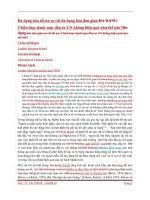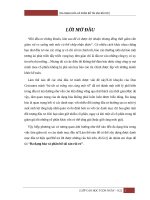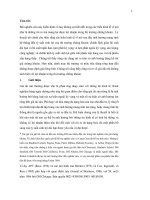Tiểu luận môn đầu tư tài chính panel data
Bạn đang xem bản rút gọn của tài liệu. Xem và tải ngay bản đầy đủ của tài liệu tại đây (1.67 MB, 68 trang )
Ho Chi Minh University of economic
Chapter 11
PANEL DATA
Company L/O/G/O
Econometric
PCompany
anel data L/O/G/O
SLIDE TEAM
-
Trần Thị Thanh Thủy
Phạm Thanh Nhất
Huỳnh Thị Bé Tư
Võ Thị Trúc Xuân
Nguyễn Thành Tân
-
GV HD: TS Phùng Đức Nam
Lớp: TC03 – K26
PCompany
anel data L/O/G/O
LEARNING OUTCOMES
-
Decribe the key features of panel data and outline the advantages and disadvantages of working with
panels data;
-
Explaind the intution
behind seemingly unrelated regressiions and propose examples of where they
may be usefully employed;
-
Constrast
the fixed effect and random effect approaches to panel model specification, determining
which is the more approaches in particular cases;
-
Estimate and interpret the results from panel unit root and cointegration test;
-
Contructs and estimate panel models in Stata.
PCompany
anel data L/O/G/O
I. Introduction – What are panel techniques and why they are use
The Nature of Panel Data
- Panel data, also known as longitudinal data, have both time series and cross sectional elements
- A panel data will embody information across both time and space. They arise when we measure the same collection of people or
objects (entities) over a period of time.
yit is the dependent variable;
is the intercept term,
is a kx1 vector of parameters to be estimated on the explanatory variables,
xit is a 1x k vector of observation on explanatory variables;
t = 1, …, T; i = 1, …, N.
PCompany
anel data L/O/G/O
I. Introduction – What are panel techniques and why they are use
The Nature of Panel Data
-
The
simplest way to deal with this data would be to estimate a pooled
regression on all the
observations together.
-
This equation would be estimated in the usual fashion using OLS
But pooling the data assumes that
the average values of the variables and the relationships between
them are constant over time for all data
PCompany
anel data L/O/G/O
I. Introduction – What are panel techniques and why they are use
The Advantages of using Panel Data
There are a number of advantages from using a full panel technique when a panel of data is available.
-
We can address a broader range of issues and tackle more complex problems with panel data than
would be possible with pure time series or pure cross sectional data alone.
-
It is often of interest to examine how variables, or the relationships between them, change dynamically
(over time).
-
By structuring the model in an appropriate way, we can remove the impact of certain forms of omitted
variables bias in regression results.
PCompany
anel data L/O/G/O
II. What panel techniques are available?
Seemingly Unrelated Regression (SUR)
-
One approach to making more full use of the structure of the data would be to use the SUR framework initially proposed
by Zellner (1962). This has been used widely in finance where the requirement is to model several closely related variables
over time.
-
A SUR is so called because the dependent variables may seem unrelated across the equations at first sight, but a more
careful consideration would allow us to conclude that they are in fact related after all.
-
Under the SUR approach, one would allow for the contemporaneous relationships between the error terms in the equations
by using a generalised least squares (GLS) technique.
-
The idea behind SUR is essentially to transform the model so that the error terms become uncorrelated. If the correlations
between the error terms in the individual equations had been zero in the first place, then SUR on the system of equations
would have been equivalent to running separate OLS regressions on each equation.
PCompany
anel data L/O/G/O
II. What panel techniques are available?
Seemingly Unrelated Regression (SUR)
-
The applicability of the SUR technique is limited because it can only be employed when the number of time
series observations per cross sectional unit is at least as large as the total number of such units, N.
-
A second problem with SUR is that the number of parameters to be estimated in total is very large, and the
variance- covariance matrix of the errors also has to be estimated. For these reasons, the more flexible full panel
data approach is much more commonly used.
-
There are two main classes of panel techniques:
1. The fixed effects estimator
2. The random effects estimator.
PCompany
anel data L/O/G/O
II. What panel techniques are available?
Seemingly Unrelated Regression (SUR)
The simplest types of fixed effects models allow the intercept in the regression model to differ cross – sectionally but not over
time, while all of the slope estimates are fixed both cross – sectionally and over time, but it still requires the estimation of (N+k)
parameters.
First, We need to distinguish between a balanced panel and unbalanced panel
-
Balanced panel: a dataset where the variables have both time series and cross – sectional dimensions, and where there are
equally long samples for each cross-sectional entity (i.e no missing data)
-
Unbalanced panel: a dataset where the variables have both time series and cross – sectional elements, but where some data
are missing (i.e where the number of time series observations avaibles is not the same for cross – sectional entities)
=>The presentation below implicity assumes that the panel is balanced
PCompany
anel data L/O/G/O
III. The Fixed Effect Model
To see how the fixed effect model works, we decompose the disturbance term, Uit, in to an individual specific effect, , and
the remainder disturbance, (that varies over time and entities)
We can think of as encapsulating all of the variables that affect yit
cross sectionally but do not vary over time – for
example, the sector that a firm operates in, a person's gender, or the country where a bank has its headquarters, etc. Thus we
would capture the heterogeneity that is encapsulated in by a method that allows for different intercepts for each cross sectional
unit.
This model could be estimated using dummy variables, which would be
(LSDV) approach.
termed the least squares dummy variable
PCompany
anel data L/O/G/O
III. The Fixed Effect Model
The LSDV model may be written
Where D1i is a dummy variable that takes the value 1 for all observations on
the first entity (e.g., the first
firm) in the sample and zero otherwise, D2i is a dummy variable that takes the value 1 for all observations on the
second entity (e.g., the second firm) and zero otherwise, and so on.
We have remove intercept term (from this equation to avoid the “dummy trap” when we have perfect
multicollinearity between the dummy variables and the intercept.
The LSDV can be seen as just a standard regression model and therefore it can be estimated using OLS.
PCompany
anel data L/O/G/O
III. The Fixed Effect Model
In order to advoid the necessity to estimate so many dummy variable paramaters, a tranformation known as the within
transformation is made to the data to simplity matter
The within transformation involves subtracting the time-mean of each entity away from the values of the variable
So define
as the time-mean of the observations for cross-sectional unit i, and similarly calculate the means
of all of the explanatory variables.
Then we can subtract the time-means from each variable to obtain a regression containing demeaned variables only.
Note that such a regression does not require an intercept term since now the dependent variable will have zero mean by
construction
The model containing the demeaned variables is
We could write this as
PCompany
anel data L/O/G/O
III. The Fixed Effect Model
An
alternative to this demeaning would be to simply run a cross-sectional regression on the time-averaged
values of the variables, which is known as the between estimator.
Between estimator: is used in the context of a fixed effect s panel model, involving running a cross –
sectional regression on the time averaged values of all varables in order to reduce the number of parameters
requiring estmation
An
advantage of running the regression on average values (the between estimator) over running it on the
demeaned values (the within estimator) is that the process of averaging is likely to reduce the effect of measurement
error in the variables on the estimation process.
PCompany
anel data L/O/G/O
III. The Fixed Effect Model
A further possibility is that instead, the first difference operator could be applied so that the model
becomes one for explaining the change in yit rather than its level. When differences are taken, any
variables that do not change over time will again cancel out.
Differencing and the within transformation will produce identical estimates in situations where
there are only two time periods.
But the major disadvantages of this process is that we lose the ability to determine the influences
of all of the variables that affects yit but do not vary over time
PCompany
anel data L/O/G/O
IV. The Time - fixed Effect Model
It is also possible to have a time fixed effects model rather than an entity fixed effects model.
We would use such a model where we think that the average value of yit changes over time but not cross sectionally.
Hence with time fixed effects, the intercepts would be allowed to vary over time but would be assumed to be the
same across entities at each given point in time. We could write a timefixed effects model as
is a timevarying intercept that captures all of the variables that affect y and that vary over time but are constant cross
sectionally.
An example would be where the regulatory environment or tax rate changes partway through a sample period. In such
circumstances, this change of environment may well influence y, but in the same way for all firms.
PCompany
anel data L/O/G/O
IV. The Time - fixed Effect Model
Time variation in the intercept terms can be allowed for in exactly the same way as with entity fixed
effects. That is, a least squares dummy variable model could be estimated
D1t, for example, denotes a dummy variable that takes the value 1 for the first time period and zero
elsewhere, and so on.
The only difference is that now, the dummy variables capture time variation rather than cross sectional
variation. Similarly, in order to avoid estimating a model containing all T dummies, a within transformation
can be conducted to subtract away the cross sectional averages from each observation
PCompany
anel data L/O/G/O
IV. The Time - fixed Effect Model
The mean of the observations on y across the entities for each time time period
We could write the equation above as
PCompany
anel data L/O/G/O
IV. The Time - fixed Effect Model
Finally, it is possible to allow for both entity fixed effects and time fixed effects within the same
model. Such a model would be termed a two way error component model, and the LSDV equivalent
model would contain both crosssectional and time dummies
The number of parameters to be estimated would now be k+N+T and the within tranformation in
this two – way model would be more complex
PCompany
anel data L/O/G/O
V. Investigating Banking Competition with a Fixed Effects Model
The UK banking sector is relatively concentrated and apparently extremely
profitable.
It has been argued that competitive forces are not sufficiently strong and that
A study by Matthews, Murinde and Zhao (2007) investigates competitive
there are barriers to entry into the market.
conditions in UK banking between 1980
and 2004 using the PanzarRosse approach.
The
model posits that if the market is contestable, entry to and exit from the market will be easy (even if the
concentration of market share among firms is high), so that prices will be set equal to marginal costs.
The technique used to examine this conjecture is to derive testable
equation.
restrictions upon the firm's reduced form revenue
PCompany
anel data L/O/G/O
V. Investigating Banking Competition with a Fixed Effects Model
Methodology
The empirical investigation consists of deriving an index (the PanzarRosse H statistic) of the sum of
the elasticities of revenues to factor costs (input prices).
If this lies between 0 and 1, we have monopolistic competition or a partially contestable equilibrium,
whereas H < 0 would imply a monopoly and H = 1
would imply perfect competition or perfect
contestability.
The key point is that if the market is characterised by perfect competition, an increase in input prices
will not affect the output of firms, while it will under monopolistic competition.
PCompany
anel data L/O/G/O
V. Investigating Banking Competition with a Fixed Effects Model
Methodology
The model Matthews et al. investigate is given by
-
REVit is the ratio of bank revenue to total assets for firm i at time t
PL is personnel expenses to employees (the unit price of labour);
PK is the ratio of capital assets to fixed assets (the unit price of capital)
PF is the ratio of annual interest expenses to total loanable funds (the unit price of funds).
PCompany
anel data L/O/G/O
V. Investigating Banking Competition with a Fixed Effects Model
Methodology
The model also includes several variables that capture timevarying bank specific effects on revenues and costs,
and these are:
-
RISKASS, the ratio of provisions to total assets
ASSET is bank size, as measured by total assets
BR is the ratio of the bank's number of branches to the total number of branches for all banks.
GROWTHt is the rate of growth of GDP, which obviously varies over time but is constant across banks at a
given point in time;
-
specific fixed effects
-
vit is an idiosyncratic disturbance term
-
Contestability parameter, H is given as:
PCompany
anel data L/O/G/O
V. Investigating Banking Competition with a Fixed Effects Model
Methodology
Unfortunately, the PanzarRosse approach is only valid when applied to a banking market in long run
equilibrium. Hence the authors also conduct a test for this, which centrer on the regression
The explanatory variables for the equilibrium test regression are identical to those of the contestability
regression but the dependent variable is now the log of the return on assets (lnROA).
Equilibrium is argued to exist in the market if
PCompany
anel data L/O/G/O
V. Investigating Banking Competition with a Fixed Effects Model
Methodology
Unfortunately, the PanzarRosse approach is only valid when applied to a banking market in longrun
equilibrium. Hence the authors also conduct a test for this, which centrer on the regression
The explanatory variables for the equilibrium test regression are identical to those of the contestability
regression but the dependent variable is now the log of the return on assets (lnROA).
Equilibrium is argued to exist in the market if
PCompany
anel data L/O/G/O
V. Investigating Banking Competition with a Fixed Effects Model
Results
-The null hypothesis that the bank fixed effects are jointly zero (H0: =0) is rejected at the 1% significance level for the
full sample and for the second subsample but not at all for the first subsample.
-Overall, however, this indicates the usefulness of the fixed effects panel model that allows for bank heterogeneity.
-The main focus of interest in the table on the previous slide is the equilibrium test, and this shows slight evidence
of disequilibrium (E is significantly different from zero at the 10% level) for the whole sample, but not for either of the
individual subsamples.
-Thus the conclusion is that the market appears to be sufficiently in a state of
equilibrium that it is valid to continue
to investigate the extent of competition using the PanzarRosse methodology. The results of this are presented on the
following slide.









